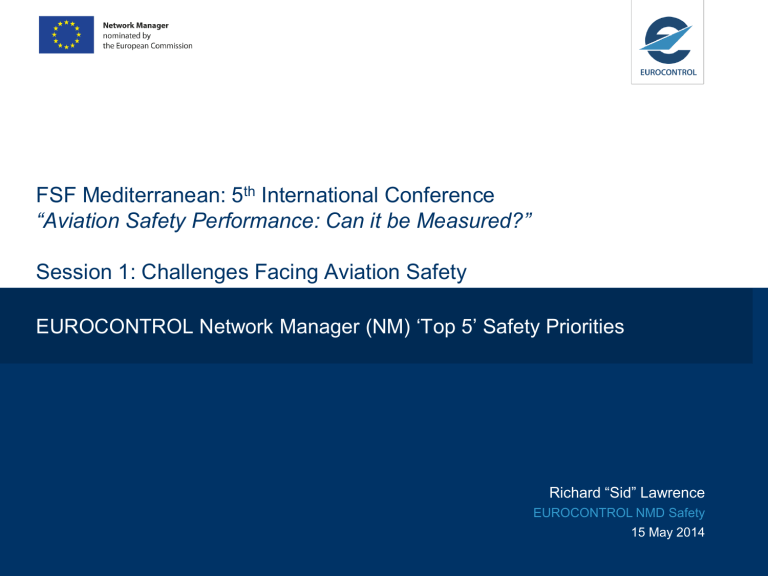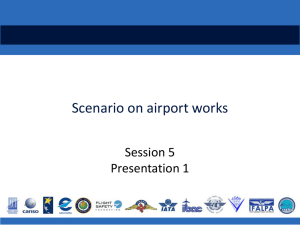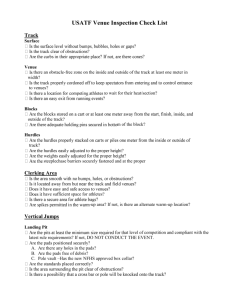Richard Lawrence

FSF Mediterranean: 5 th International Conference
“Aviation Safety Performance: Can it be Measured?”
Session 1: Challenges Facing Aviation Safety
EUROCONTROL Network Manager (NM) ‘Top 5’ Safety Priorities
Richard “Sid” Lawrence
EUROCONTROL NMD Safety
15 May 2014
Identifying the NM ‘Top 5’ - Scope
Strategic fit and challenge
The Process
The ‘Top 5’
Deliverables
Where are we now?
Questions
C
A
P
A
I
C
T
Y
S
A
F
E
T
Y
SES
ATM NETWORK
PERFORMANCE
E
I
E
N
C
Y
F
F
I
C
NETWORK MANAGER
I
R
O
N
M
E
N
T
E
N
V
Operational Safety Task
Regulatory Chain Service Provision Chain
EC, EASA, NSAs:
Safety Rulemaking,
Certification
Safety Oversight
NM, Aviation
Operators:
Safety Management
Operational Safety
Safety Culture
NM safety work programme fully coordinated with EASA; non-regulatory.
Some deliverables contribute towards EASA European Aviation Safety Plan (EASp).
NM Safety – ‘Top 5’ Strategic Fit
Network
Strategy
Plan
Network
Plan Operations
Plan
NM Safety:
Identify Top 5 operational ATM
Safety priorities
Identify operational safety risks to mitigate safety risks at network level using relevant network safety data.
NM
Implementing
Rule revision:
Safety
Management
The Challenge – find the ‘Top 5’ Operational ATM
Safety Risk Priorities
How do we identify and prioritise the most important operational ATM risks facing the Network?
Strategic fit - respond to the Network Manager mandate /
Network Strategy Plan - provide baseline for Network Top 5
Operational Safety Risk Priorities
More systematic review of risk areas
More explicit portfolio of initiatives and deliverables
Enhance the collaborative decision making
Another challenge, how to make sense of the available safety performance data/knowledge:
Challenge
NM Safety Improvement Sub Group (SISG) in 2012:
Let’s see what we did…
Where to put the SISG work priorities?
ORG ENABLERS OPS THREATS
SMS Maturity
Safety
Culture
Competency system
AG Comm. issues
Severe WX
Risks
Technical failures
Laser
Illumination
ATC Sector
Overloads
PRECURSORS OUTCOMES
Loss of
Separation
Airspace
Infringement
Runway
Incursion
CFTT
Mid-air collision
Ground
Collision
CFIT
RE
Unstabilised
Approach
The Process step-by-step: Potential Risk Areas
1. ANSPs’
Safety Priorities
2. Suggested
Priorities
3. Collaborative decision
4. In-depth analysis
5. Improvement
Actions
•Loss of Separation
•Runway Incursion
•Airspace Infringements (inside CAS)
•Weather
•Unstabilised Approaches
•Level Busts
•Military activity
•Oceanic Ops
•Air Ground Communications
•ANSP/ANSP Interface (internal and external coordination)
•Ground operations
•GA at small airports
•Go-Arounds/Missed Approach
•Safety Nets
•Systemic handling of Active Danger areas
•Aircraft technical problems/unusual situations
•Birdstrikes
•Laser Illumination
•Hot spots (route intersections)
•Crossing traffic (airspace design)
•Technical failures
•Runway excursion
•FOD
•STCA
•Simultaneous/Blocked Transmissions
•HOTO
The Process step-by-step: Suggested Risk
Priorities
1. ANSPs’
Safety Priorities
2. Suggested
Priorities
3. Collaborative decision
4. In-depth analysis
5. Improvement
Actions
2.1
Criticality of the Risk Areas how close events are to an accident
Runway Incursion
Loss of separation
Airspace Infringement (of Controlled Airspace)
Runway Excursion
Incident after Unstabilised Approach
Level Bust
Adverse weather conditions
ATC position/sector overloads
Air-Ground Communication Incidents
HOTO Incidents
The process step-by-step : Suggested Risk
Priorities
1. ANSPs’
Safety Priorities
2. Suggested
Priorities
3. Collaborative decision
4. In-depth analysis
5. Improvement
Actions
2.2
Suggested Priorities
• Airspace Infringement
• Runway Incursion
•
Loss of Separation
• ATC sector overloads
• Level Bust
• Go Around Safety
• Severe Weather Risk
• Air Ground communications
The Process step-by-step: Agreed Risk Priorities
1. ANSPs’
Safety Priorities
2. Suggested
Priorities
3. Collaborative decision
4. In-depth analysis
5. Improvement
Actions
3
Safety Team - Risk Review
• Runway Incursion
•
Loss of Separation
Simplified SAFMAP – Barriers
Providence
UNRESOLVED BY ATC AND PILOT/DRIVER RUNWAY CONFLICT
Pilot/Driver RWY Collision Avoidance
UNRESOLVED BY ATC RUNWAY CONFLICT
ATC RWY Collision Avoidance
RUNWAY CONFLICT
Preventing Runway Incursion to turn into RWY conflict
RUNWAY INCURSION
Preventing Runway Incursion
Findings - The efficiency of the barriers
PROVIDENCE
COLLISION AVOIDANCE BY
PILOT OR VEHICLE DRIVER
COLLISION AVOIDANCE BY
ATC
CONFLICT
PREVENTION
RWY
INCURSION
PREVENTION
10
WORKED
8
FAILED
36
11
26
18
7
7
Findings – Runway Safety
No landing without clearance
14% sufficient spacing
8%
Detecting nonintended runway use
28% other
6%
72%
Detecting
RWY still occupied
44%
Runway Incursion – ‘Top 5’Priorities:
Landing without Clearance
Detecting occupied runway
Loss of Separation En Route – ‘Top 5’ Priorities:
Risk of operations without a transponder or with a dysfunctional one
‘Blind spot’
Conflict detection with adjacent sectors
‘Top 5’ ATM Operational Safety Priorities for 2013
14/04/2020 21
The Process step-bystep: ‘Top 5’ Studies
1. ANSPs’
Safety Priorities
2. Suggested
Priorities
3. Collaborative decision
4. Top 5 Study
5. Improvement
Actions
4.1
Collect information for the specific risk area
4.2
Analyse the causes and their interdependence
4.3
Consolidate Suggested Safety Enhancements
Where are we today?
‘Top 5’ Safety Studies launched in 2013 – ongoing, nearing completion.
Prioritisation exercise repeated using 2012/3 data.
Results broadly similar – therefore, retain current ‘Top 5’ until completion of
Studies.
However, runway incursion data revealed involvement of vehicles in RI incidents remains prevalent – intend to undertake survey of aerodromes/ANSPs:
‘Best’ practices for aerodrome driving etc
Effectiveness of EAPPRI recommendations
Possible Safety Study
Have we met the challenge?
We think so!
Structured, collaborative and robust process but without being over burdensome and time-consuming.
Uses existing safety data and contributes to our understanding of operational safety performance.
Enhances our collective safety knowledge and enables it to be widely spread to help others across the Network improve their safety performance.
2014 Safety Forum - Airborne Conflict
Date: 10 – 11 June
Venue: EUROCONTROL HQ Brussels
Registration closes soon! safety.forum@eurocontrol.int
Questions?
Top 5 Safety Priorities 27




